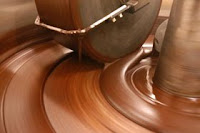Chocolate Making Process: Pod to Bar
- Cocoa pod picked
- Pod "shelled" to reveal cocoa bean
- Beans fermented (2 - 8 days) to develop sugars and prevent too much bitterness
- Beans dried
- Beans roasted to develop the chocolate flavour
- Beans shelled to reveal cocoa nibs
- Nibs ground to a fjne paste or liquid ("cocoa liquor")
- Cocoa liquor can either be sold in solid blocks or it can be heated to separate the cocoa butter from the cocoa solids (essentially cocoa powder)
- Cocoa liquor, cocoa solids, cocoa butter, sugar, dairy, fat and flavourings etc can be combined in various combinations to make many chocolate products.
| 1. Cocoa pod picked |
| 2. Pod "shelled" to reveal cocoa bean 3. Beans fermented 4. Beans dried |
| 5. Beans roasted |
 | ||
| 6. Beans shelled to reveal cocoa nibs 7. Nibs ground to make "cocoa liquor" |
| Cocoa Powder |
| Cocoa Butter |
Tempering Chocolate
This was my primary reason for writing this section of the blog as I have only now got a proper understanding of the science behind tempering. I knew the principals before, but never really knew WHY we heat and cool chocolate to precise temperatures in order to temper it!..........Here's how you do it and why;
When you buy a good quality bar of chocolate from the shops, it is already in a state of temper. That is, shiny, crisp and capable of withstanding standing temperatures up to 34 degrees C before it melts. If we were to heat and melt this bar of chocolate above 36 degrees C, then let it
cool to below 17 degrees C, we would end up with chocolate that is crumbly, dull in appearance and it would simply melt with ease in
your hands.
So, how do you get chocolate into a state of temper? This is where temperature manipulation of the fat crystals in the cocoa butter comes in. Cocoas butter is comprised of 6 different types of fat crystals, all with different characteristics. These crystals and their characteristics are outlined below.
Crystal Melting Temp Characteristcs
I 17°C (63°F) Soft, crumbly, melts too easily.
II 21°C (70°F) Soft, crumbly, melts too easily.
III 26°C (78°F) Firm, poor snap, melts too easily.
IV 28°C (82°F) Firm, good snap, melts too easily.
V 34°C (94°F) Glossy, firm, best snap, melts near body temperature (37°C).
VI 36°C (97°F) Hard, takes weeks to form.
Of these 6 fat
crystals, only 1 is desirable for tempered chocolate. This is crystal V, the "beta" crystal.
Proper tempering is all about forming the type V crystals. This provides the best appearance, mouthfeel and creates the most stable crystals so the texture and appearance will not degrade over time. To accomplish this, the temperature is carefully manipulated during the crystallization.
The chocolate is first heated to melt all six forms of crystals (heat dark chocolate to 45 - 50 degrees C, milk chocolate to 40 - 45 degrees C, and white chocolate to 40 degrees C). Then the chocolate is cooled to allow crystal types IV and V to form (VI takes too long to form) (cool dark chocolate to 28 - 29 degrees C, milk chocolate to 27 - 28 degrees C, and white chocolate to 24 - 25degrees C). At this temperature, the chocolate is agitated to create many small crystal "seeds" which will serve as the nuclei to create small crystals in the chocolate. The chocolate is then heated to eliminate any type IV crystals, leaving just the type V (heat dark chocolate to 31 - 32 degrees C, milk chocolate to 30 - 31 degrees C, and white chocolate to 27 - 28 degrees C). After this point, any excessive heating of the chocolate will destroy the temper and this process will have to be repeated.
Two classic ways of tempering chocolate are:
Working the melted chocolate on a heat-absorbing surface, such as a stone slab, until thickening indicates the presence of sufficient crystal "seeds". The chocolate is then gently warmed to working temperature.
Stirring solid chocolate into melted chocolate to "inoculate" the liquid chocolate with crystals (this method uses the already formed crystal of the solid chocolate to "seed" the melted chocolate).
It IS possible to melt tempered chocolate whilst still keeping it in temper. You have to melt the chocolate carefully to the tempering range (31 - 32 degrees C for dark chocolate etc) in order to maintain as many V crystals as possible. However, if the chocolate is heated above this range, the V crystals will be destroyed and you will have to re-temper the chocolate the hard way!
Great post full of useful tips! My site is fairly new and I am also having a hard time getting my readers to leave comments. Analytics shows they are coming to the site but I have a feeling “nobody wants to be first”.gres cacao
ReplyDelete